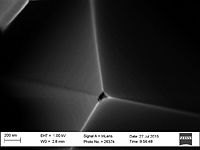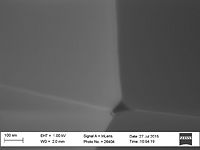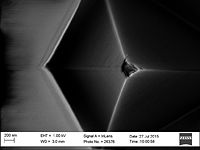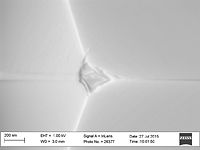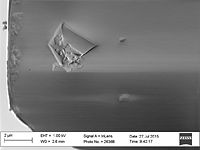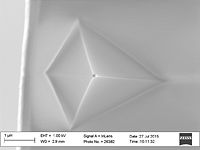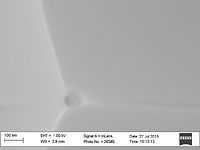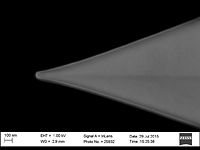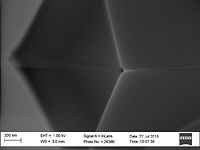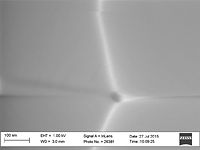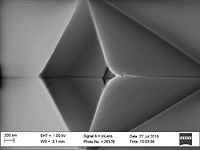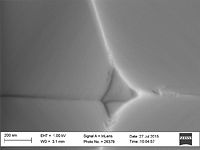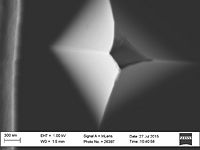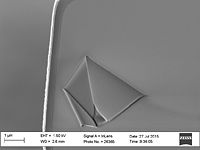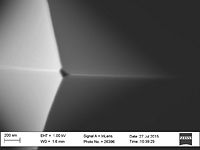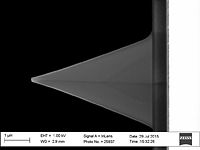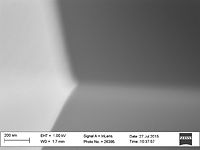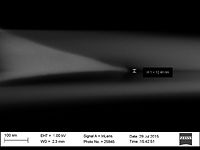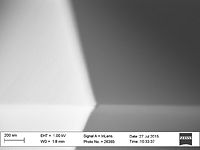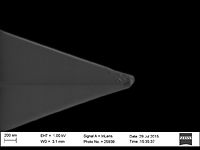Specific Process Knowledge/Characterization/AFM: Atomic Force Microscopy/Workspaces: Difference between revisions
| (20 intermediate revisions by the same user not shown) | |||
| Line 1: | Line 1: | ||
'''Feedback to this page''': '''[mailto:labadviser@danchip.dtu.dk?Subject=Feed%20back%20from%20page%20http://labadviser.danchip.dtu.dk/index.php/Specific_Process_Knowledge/Characterization/AFM:_Atomic_Force_Microscopy/Workspaces click here]''' | '''Feedback to this page''': '''[mailto:labadviser@danchip.dtu.dk?Subject=Feed%20back%20from%20page%20http://labadviser.danchip.dtu.dk/index.php/Specific_Process_Knowledge/Characterization/AFM:_Atomic_Force_Microscopy/Workspaces click here]''' | ||
=What scanning mode, experiment/workspace and probe should | ''This page is written by Berit Herstrøm @ DTU Nanolab '' | ||
=What scanning mode, experiment/workspace and probe should be select= | |||
{|border="1" cellspacing="1" cellpadding="3" style="text-align:left;" | {|border="1" cellspacing="1" cellpadding="3" style="text-align:left;" | ||
| Line 19: | Line 21: | ||
|-style="background:WhiteSmoke; color:black" | |-style="background:WhiteSmoke; color:black" | ||
!Recommended mode | !Recommended mode | ||
|Roughness measurement can be done in both Contact, Tapping and ScanAsyst mode. We recommend '''ScanAsyst mode''' because of less chance of (non-uniform) deformation of the sample and less tip wear | |Roughness measurement can be done in both Contact, Tapping and ScanAsyst mode. We recommend '''Tapping mode''' or '''ScanAsyst mode.''' Tapping mode works fine for hard samples as silicon, metals and so on. ScanAsyst mode is recommended for soft samples, soft polymer, cells and the like because of less chance of (non-uniform) deformation of the sample and less tip wear. ScanAsyst is easier use but tapping mode is less sensitive to the tip wear. | ||
|For Topographic measurements with no steep/abrupt steps we also recommend ''' | |For Topographic measurements with no steep/abrupt steps we also recommend '''Tapping mode''' on most samples. Only on very soft samples (e.g. cells) we recommend ''ScanAsyst'' due to less chance of (non-uniform) deformation of the sample - or if you need QNM data. We mainly recommend '''Tapping mode''' because we experience less problems when the tip end is slightly broken. | ||
|For Steep/abrupt steps but no high aspect ratio structures we still recommend '''Tapping mode''' | |For Steep/abrupt steps but no high aspect ratio structures we still recommend '''Tapping mode''' unless you need need QNM data. | ||
|For High aspect ratio measurements we recommend Tapping mode. | |For High aspect ratio measurements we recommend Tapping mode. We do not have experience with ScanAsyst therefore we recommend '''Tapping mode'''. This requires special probes. You can buy this probes for both Tapping mode and ScanAsyst. They are at the moment (sep-2025) more expensive for ScanAsyst mode. | ||
|For large scan areas where you prioritize to scan fast then you can use '''contact mode'''. Here you can scan with scan rate of up to 2.43 Hz | |For large scan areas where you prioritize to scan fast then you can use '''contact mode'''. Here you can scan with scan rate of up to 2.43 Hz | ||
|- | |- | ||
| Line 34: | Line 36: | ||
'''[https://www.nanoandmore.com/AFM-Probe-Tap150Al-G Tap150Al-G]''' or '''[http://www.nanoandmore.com/AFM-Probe-Tap300Al-G TAP300Al-G]''' for Tapping mode | '''[https://www.nanoandmore.com/AFM-Probe-Tap150Al-G Tap150Al-G]''' or '''[http://www.nanoandmore.com/AFM-Probe-Tap300Al-G TAP300Al-G]''' for Tapping mode | ||
|'''[http://www.nanoandmore.com/AFM-Probe-AR5T-NCHR AR5T-NCHR]''' or | |'''[http://www.nanoandmore.com/AFM-Probe-AR5T-NCHR AR5T-NCHR]''' or | ||
'''[http://www.brukerafmprobes.com/p-3679-fib6-400a.aspx FIB6-400A]''' | '''[http://www.brukerafmprobes.com/p-3679-fib6-400a.aspx FIB6-400A]''' <br> | ||
or '''[https://www.brukerafmprobes.com/p-4050-pfdt350.aspx PFDT350 for ScanAsyst mode] | |||
|'''[https://www.brukerafmprobes.com/p-3693-snl-10.aspx SNL]''' | |'''[https://www.brukerafmprobes.com/p-3693-snl-10.aspx SNL]''' | ||
|- | |- | ||
| Line 42: | Line 45: | ||
!Recommended experiment/Workspace | !Recommended experiment/Workspace | ||
| | | | ||
Check the user manual in LabManager | |||
| | | | ||
Check the user manaual in LabManager | |||
| | |Check the user manaual in LabManager | ||
|'''TappingMode 300nm trench''' (for steps <~1µm) | |'''TappingMode 300nm trench''' (for steps <~1µm) | ||
'''Tappping mode in air - 6µm Deep Trench''' (for steps >1~µm) | '''Tappping mode in air - 6µm Deep Trench''' (for steps >1~µm) | ||
| Line 59: | Line 62: | ||
==More information about de different modes== | ==More information about de different modes== | ||
===Contact, Tapping and Peak Force Tapping=== | ===Contact, Tapping and Peak Force Tapping=== | ||
Please flowing this link to | Please flowing this link to down load the file from LabManager (Requires login): <br> | ||
[https://labmanager.dtu.dk/view_binary.php?fileId=5340 Introduction to Bruker ScanAsyst and PeakForce tapping AFM technology] | [https://labmanager.dtu.dk/view_binary.php?fileId=5340 Introduction to Bruker ScanAsyst and PeakForce tapping AFM technology] | ||
===PeakForce tapping and quantitative nanomechanical mapping=== | ===PeakForce tapping and quantitative nanomechanical mapping=== | ||
*Application note on QNM: [https://labmanager.dtu.dk/view_binary.php?fileId=5404 requires login] | |||
* | |||
===Peak Force KPFM (Kelvin Probe Force Microscopy)=== | ===Peak Force KPFM (Kelvin Probe Force Microscopy)=== | ||
*Application note on KPFM: [[ | *Application note on KPFM: [[File: PeakForce-Kelvin-Probe-Force-Microscopy-App-Note-BRUKER.pdf]] - used with permission | ||
=Evaluation of used probes= | =Evaluation of used probes= | ||
This evaluation was done to know if the tip end of the ScanAsyst probes was typically dirty or broken when we got bad images. If it was dirty, maybe we could find a way to clean it. If it was broken off we needed to replace it. It turned out it was in most cases broken. | |||
{| border="1" cellspacing="1" cellpadding="2" align="left" | {| border="1" cellspacing="1" cellpadding="2" align="left" | ||
! Box number and probe number | ! Box number and probe number | ||
Latest revision as of 14:56, 4 September 2025
Feedback to this page: click here
This page is written by Berit Herstrøm @ DTU Nanolab
What scanning mode, experiment/workspace and probe should be select
| Roughness measurements | Topographic measurements with no steep/abrupt steps | Steep/abrupt steps but no high aspect ratio | High aspect ratio measurements | Large area fast scan | |
|---|---|---|---|---|---|
| Recommended mode | Roughness measurement can be done in both Contact, Tapping and ScanAsyst mode. We recommend Tapping mode or ScanAsyst mode. Tapping mode works fine for hard samples as silicon, metals and so on. ScanAsyst mode is recommended for soft samples, soft polymer, cells and the like because of less chance of (non-uniform) deformation of the sample and less tip wear. ScanAsyst is easier use but tapping mode is less sensitive to the tip wear. | For Topographic measurements with no steep/abrupt steps we also recommend Tapping mode on most samples. Only on very soft samples (e.g. cells) we recommend ScanAsyst due to less chance of (non-uniform) deformation of the sample - or if you need QNM data. We mainly recommend Tapping mode because we experience less problems when the tip end is slightly broken. | For Steep/abrupt steps but no high aspect ratio structures we still recommend Tapping mode unless you need need QNM data. | For High aspect ratio measurements we recommend Tapping mode. We do not have experience with ScanAsyst therefore we recommend Tapping mode. This requires special probes. You can buy this probes for both Tapping mode and ScanAsyst. They are at the moment (sep-2025) more expensive for ScanAsyst mode. | For large scan areas where you prioritize to scan fast then you can use contact mode. Here you can scan with scan rate of up to 2.43 Hz |
| Recommended probes | Tap150Al-G or ScanAsyst in air | Tap150Al-G or ScanAsyst in air | Tap150Al-G or ScanAsyst in air for ScanAsyst mode
Tap150Al-G or TAP300Al-G for Tapping mode |
AR5T-NCHR or | SNL |
| Recommended experiment/Workspace |
Check the user manual in LabManager |
Check the user manaual in LabManager |
Check the user manaual in LabManager | TappingMode 300nm trench (for steps <~1µm)
Tappping mode in air - 6µm Deep Trench (for steps >1~µm) |
Standard Contact mode |
*By choosing the work space/experiment QNM in air (Mechanical properties - QNM in air) scanAsyst is included and so are the nanomechanical properties like modulus, adhesion, dissipation and deformation.
More information about de different modes
Contact, Tapping and Peak Force Tapping
Please flowing this link to down load the file from LabManager (Requires login):
Introduction to Bruker ScanAsyst and PeakForce tapping AFM technology
PeakForce tapping and quantitative nanomechanical mapping
- Application note on QNM: requires login
Peak Force KPFM (Kelvin Probe Force Microscopy)
- Application note on KPFM: File:PeakForce-Kelvin-Probe-Force-Microscopy-App-Note-BRUKER.pdf - used with permission
Evaluation of used probes
This evaluation was done to know if the tip end of the ScanAsyst probes was typically dirty or broken when we got bad images. If it was dirty, maybe we could find a way to clean it. If it was broken off we needed to replace it. It turned out it was in most cases broken.

